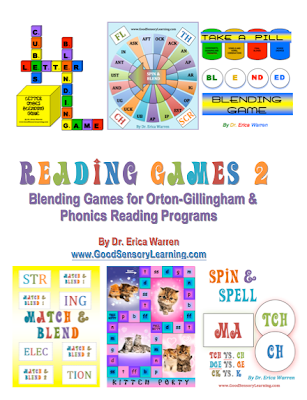This week I wanted to tell you about my online store, Good Sensory Learning. I’m Dr. Erica Warren, and I established this site so I could share all the materials that I have created over the last 20+ years as a learning specialist and educational therapist. When I first began my private practice, Learning to Learn, I had great difficulty finding fun and multisensory materials for my students that were effective and engaging. So back in 2005, I made it my mission to design and distribute high-end, remedial products as well as memorable, motivating lessons that bring delight to learning. If you would like to try a free sampling of my activities , CLICK HERE . How Are the Products Organized at Good Sensory Learning? You can download my Free Printable Catalog or you can browse the site using the grey “search all products” bar in the top right of any page with keywords such as dyslexia, working memory, and executive functioning. What’s more, drop down menus in the red banner allow you t...
It’s wonderful when giggles of joy and excitement ring through the classroom as young students eagerly learn the skills needed to be proficient readers. Learning centers or reading centers are often the place where this can happen, but the trick to tickling your students attention often lies in multisensory, interactive activities or games.
 Here is a fun phonemic awareness activity I designed that you can make with old recycled pill or vitamin containers and other common household goods. It’s a wonderful learning center idea that will help students blend phonics sounds into words.
Here is a fun phonemic awareness activity I designed that you can make with old recycled pill or vitamin containers and other common household goods. It’s a wonderful learning center idea that will help students blend phonics sounds into words.
1) Collect and clean old vitamin or pill containers. I like to use the clear, colorful ones.
2) Decide upon the playing pieces. I use a 1 inch hole puncher with thick cardstock, large lima beans, or wooden craft discs.
3) Place consonants, blends, digraphs, word endings or more onto both sides of the playing pieces. I like to color code the pieces to match the color of the container so that clean up is quick and easy.
4) Label the containers as illustrated or as you like.
2) Decide upon the playing pieces. I use a 1 inch hole puncher with thick cardstock, large lima beans, or wooden craft discs.
3) Place consonants, blends, digraphs, word endings or more onto both sides of the playing pieces. I like to color code the pieces to match the color of the container so that clean up is quick and easy.
4) Label the containers as illustrated or as you like.
How to play (2-4 players):
 The object of the game is for players to select “a pill” from each container and try to make a word by blending the sounds. If a player can make one word or more, they write down the biggest word on a score sheet and collect one point for every letter used in their word. After each round, the playing pieces are returned to the appropriate container. Players shake the bottles and then select new pieces. After ten rounds, the winner is the player with the highest score.
The object of the game is for players to select “a pill” from each container and try to make a word by blending the sounds. If a player can make one word or more, they write down the biggest word on a score sheet and collect one point for every letter used in their word. After each round, the playing pieces are returned to the appropriate container. Players shake the bottles and then select new pieces. After ten rounds, the winner is the player with the highest score.
If you like this game, you will love my newest Reading Games 2 publication. Come check it out! There, you can also download a full, freebie sample board game! http://goodsensorylearning.com/reading-games.html
Cheers, Erica
Cheers, Erica
· Blog: https://learningspecialistmaterials.blogspot.com/
· YouTube Channel: https://www.youtube.com/user/warrenerica1
· Podcast: https://godyslexia.com/
· Store: http://www.Goodsensorylearning.com/ & www.dyslexiamaterials.com
· Courses: http://www.learningspecialistcourses.com/
· Newsletter Sign-up: https://app.convertkit.com/landing_pages/69400


Comments
Post a Comment